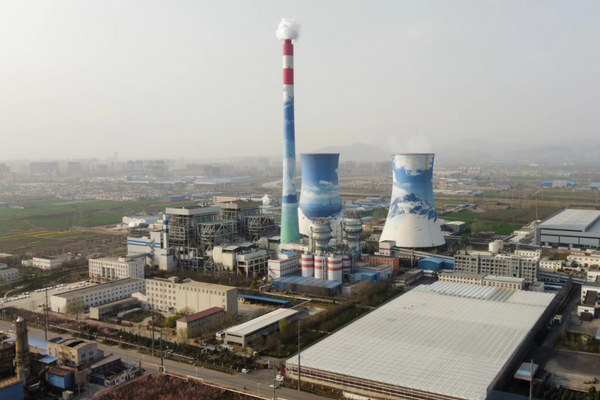Among the many carbon-neutral technology paths, there is an idea of using vegetable factories to enhance carbon capture capacity. Recently, Hortidaily invited Mr. Wang Xiaoqing, chairman of TsingSky Agricultural Technology, to share with us about digital carbon sequestration.
TsingSky's carbon neutrality demonstration plant in Mengzhuang Town, Huixian City, Henan Province, is the first agricultural carbon neutrality demonstration farm in China. By combining the waste heat and carbon dioxide generated by the thermal power generation of Henan Mengdian Group with TsingSky’s vegetable cultivation, the photosynthesis of crops is used to fix carbon dioxide into organic matter, thereby achieving carbon neutrality in agriculture. The current power generation capacity is about 2 × 330 MW, and the annual carbon dioxide emissions can reach 2.4 million tons. Mr. Wang shared, "Logically, there are two directions for reducing carbon dioxide: one is to reduce input, that is, to transform our energy acquisition methods in the shortest time, and no longer use carbon-rich fuel such as oil, coal, and natural gas. Also, reduce carbon dioxide produced by human activities; the second is to increase consumption, that is, to maximize the environmental and artificial carbon dioxide fixation capacity. Forests and green vegetation are well-known carbon dioxide absorbers, but they are slow to take effect. The carbon sequestration logic of vegetable farms is basically the same as that of forest parks. The biggest difference is that it is possible to increase the concentration of carbon dioxide in vegetable farms. The concentration of carbon dioxide in the air is about 300-400ppm, and it can reach 800-1200ppm when used in vegetable greenhouses. As the concentration of carbon dioxide increases, the overall photosynthesis will undergo some changes. "

"Currently, there are many power plants in China, and the country has strict emission standards for the exhaust gas emitted by major power plants, and the content of carbon monoxide and sulfur dioxide is already very small; in addition, the greenhouse needs ventilation, and good ventilation will not lead to plant poisoning. It is totally possible to utilize this part of carbon dioxide. Also, because there is no need to extract and liquefy carbon dioxide, the cost per ton of carbon dioxide is very low. On average, one ton of coal can produce 2.6 tons of carbon dioxide, which is a good nutrient for vegetables. Making good use of carbon dioxide can not only reduce costs, but also generate additional benefits. Of course, this operation has certain requirements regarding equipment and technical connections. For example, some links of the power plants need to be opened during use, which requires the power plants to need certain qualifications. Not only this, the requirements for the operation capacity of the power plant are also very high, because there are many variables in agriculture, and both planting and post-sales must be considered. "

"Looking at the agricultural industry chain, we have a lot of work to do to reduce carbon emissions in production, processing, transportation, sales and other links. The amount of water and fertilizer used in the production process, as well as recyclable packaging, whether the transportation vehicle is green and electric, and the distance of transportation can all be used as criteria for reducing carbon emissions. I think the carbon neutrality indicator needs to be carefully calculated per kilogram of agricultural products, not how much is produced per hectare of land. The water, fertilizer, labor, and energy required for each kilogram of agricultural products need to be accurate. We are promoting the development of corresponding carbon-neutral standards. , China's first low-carbon agriculture conference was also held recently in Zhejiang. "

"Tomato, as a highly light-loving crop, has a strong carbon sequestration ability and is the target of our key experiments. With the further enrichment of methodologies in the future, we will also develop carbon sequestration methodologies for other crops. Currently, we are developing applicable China's carbon neutrality method. In the future, we can also bring carbon sequestration methodologies to the world, and generate more international cooperation to promote carbon neutrality."
"In my opinion, industries should be connected with each other. The combination of industry and agriculture can effectively solve the problem of high energy costs in the process of agricultural production. For agricultural production, we should not only see the economic value brought by agricultural production. The ecological value should also be used as a measurement standard. As more and more consensus is formed, agriculture will become the main force of carbon neutrality in the future, and the benefits of carbon neutrality in agriculture will also exceed the benefits of agricultural products.”
"It takes a long process for any new thing to be accepted. Carbon neutrality is still a concept, and to a certain extent, it is also a challenge to the original lifestyle. Better sustainable development requires more people to start from themselves, understand and practice. We can see that many financial institutions and investment institutions are currently paying attention to carbon neutrality, but the specific direction of implementation is still being explored. TsingSky has invested a lot in research and development, and methodology development, and aims to promote the establishment of standards. Carbon neutrality is a global thing, and we are very happy to collaborate with colleagues around the world who have this idea. "
For more information:
TsingSky Technology
Wang Xiaoqing
wxq@tsingsky.com
www.tsingsky.com
